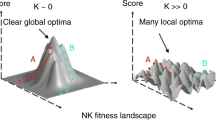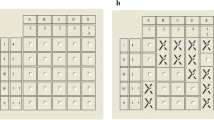Abstract
Despite the rich and interdisciplinary debate on the role of diversity and communication in group problem-solving, as well as recognition of the interactions between the two topics, they have rarely been treated as a joint research issue. In this paper, we develop a computational approach aimed at modeling problem-solving agents and assess the influence of various levels of diversity and communication in teams on agents’ performance in problem-solving. By communication, we intend a conversation on the persuasiveness of the features characterizing problem-setting. By diversity, we mean differences in how agents build problem representations which allow them to access various solutions. We deploy the concept of diversity along two dimensions: knowledge amplitude, which accounts for the level of available knowledge allowing access to poorer or richer problem representations (compared with complete problem representations), and knowledge variety, which pertains to the differences in the constituents of agents’ representations. We define performance as the frequency with which diverse agents choose the same alternative representation of an agent displaying complete representations of the problem. Our results indicate that communication is more effective when agents elaborate from relatively richer problem representations, as this provides a basis for integrating the variously diverse beliefs of their teammates. Conversely, poorer diverse representations may lead to worse performance when knowledge variety also applies. Lastly, we show that the influence of communication is not monotonically positive, as increasing communication intensity performance may worsen at any level of knowledge availability and knowledge variety.
Similar content being viewed by others
References
Ahn TK, Isaac RM, Salmon TC (2008) Endogenous group formation. J Public Econ Theory 10: 171–194. doi:10.1111/j.1467-9779.2008.00357.x
Ancona D, Caldwell D (1992) Demography and design: predictors of new product team performance. Organ Sci 3: 321–341. doi:10.1287/orsc.3.3.321
Axelrod R (1997) The complexity of cooperation. Agent-based models for competition and collaboration. Princeton University Press, Princeton
Azmitia M (1988) Peer interaction and problem solving: when are two heads better than one?. Child Dev 59: 87–96. doi:10.1080/17405620701860165
Bantel K, Jackson S (1989) Top management and innovations in banking: does the composition of the team make a difference. Strateg Manage J 10: 107–124. doi:10.1002/smj.4250100709
Barron B (2003) When smart groups fail. J Learn Sci 12: 307–359. doi:10.1207/S15327809JLS1203_1
Carpenter M (2002) The implications of strategy and social context for the relationship between top management team heterogeneity and firm performance. Strateg Manage J 23: 275–284. doi:10.1002/smj.226
Chatman JA, Flynn FJ (2001) The Influence of Demographic Heterogeneity on the Emergence and Consequences of Cooperative Norms in Work Teams. Acad Manag J 44: 956–974
Daiute C, Dalton B (1993) Collaboration between children learning to write: can novices be masters?. Cognit Instr 10: 281–333. doi:10.1207/s1532690xci1004_1
Deetz S (2001) Conceptual foundations. In: Putnam L, Jablin F (eds) The new handbook of organizational communication. Sage, Thousand Oaks, pp 3–46
Eliasmith C, Thagard P (1997) Waves, particles, and explanatory coherence. Br J Philos Sci 48: 1–19. doi:10.1093/bjps/48.1.1
Festinger L (1954) A theory of social comparison processes. Hum Relat 7: 117–140. doi:10.1177/001872675400700202
Frigotto ML, Rossi A (2006) Modeling strategic decision making in novel contexts: a constraint satisfaction approach. Quaderno DISA n. 117, Department of Computer and Management Sciences, Trento University, Italy.
Geard NL, Bullock S (2008) Group formation and social evolution: a computational model. In: Bullock S, Noble J, Watson R, Bedau M (eds) Artificial life XI: proceedings of the eleventh international conference on the simulation and synthesis of living systems. MIT Press, Cambridge, MA, pp 197–203
Guzzo R, Dickson M (1996) Teams in organizations: recent research on performance and effectiveness. Annu Rev Psychol 47: 307–338. doi:10.1146/annurev.psych.47.1.307
Hoffman L (1959) Homogeneity and member personality and its effect on group problem solving. J Abnorm Soc Psych 58: 27–32. doi:10.1037/h0043499
Hoffman L, Maier N (1961) Quality and acceptance of problem solutions by members of homogeneous and heterogeneous groups. J Abnorm Soc Psych 62: 401–407. doi:10.1037/h0044025
Hong L, Page S (2001) Problem solving by heterogeneous agents. J Econ Theory 97: 123–163. doi:10.1006/jeth.2000.2709
Hong L, Page S (2004) Groups of diverse problem solvers can outperform groups of high-ability problem solvers. PNAS 101: 16385–16389. doi:10.1073/pnas.0403723101
Hopfield JJ (1982) Neural networks and physical systems with emergent collective computational abilities. PNAS 79: 2554–2558. doi:10.1073/pnas.79.8.2554
Huck S, Rey-Biel P (2006) Endogenous leadership in teams. J Inst Theor Econ 162: 253–261. doi:10.1628/093245606777583495
Hutchins E (1995) Cognition in the wild. The MIT Press, Cambridge
Ilgen DR (1999) Teams embedded in organizations: some implications. Am Psychol 54: 129–139. doi:10.1037/0003-066X.54.2.129
Jackson SE, Joshi A, Erhardt NL (2003) Recent research on team and organizational diversity: SWOT analysis and implications. J Manage 29: 801–830. doi:10.1016/S0149-2063_03_00080-1
Jackson SE, Stone VK, Alvarez EB (1992) Socialization amidst diversity: the impact of demographics on work team oldtimers and newcomers. In: Cummings LL, Staw W (eds) Research in organizational behavior, vol 15. JAI Press, Greenwich, pp 45–109
Jehn KA, Northcraft GB, Neale MA (1999) Why differences make a difference: A field study of diversity, conflict, and performance in workgroups. Adm Sci Quart 44: 741–763
John-Steiner V (2000) Creative collaboration. Oxford University Press, New York
Keil FC (2006) Explanation and understanding. Annu Rev Psychol 57: 227–254. doi:10.1146/annurev.psych.57.102904.190100
Keser C, Montmarquette C (2007) Voluntary teaming and effort. Discussion Papers of DIW Berlin 745, DIW Berlin, German Institute for Economic Research
Kilduff M, Angelmar R, Mehra A (2000) Top-management team diversity and firm performance: examining the role of cognitions. Organ Sci 11: 21–34. doi:10.1287/orsc.11.1.21.12569
Kocher M, Strauß S, Sutter M (2006) Individual or team decision-making—causes and consequences of self-selection. Game Econ Behav 56: 259–270. doi:10.1016/j.geb.2005.08.009
Kozlowski SWJ, Klein KJ (2000) A multilevel approach to theory and research in organizations: contextual, temporal, and emergent processes. In: Klein KJ, Kozlowski SWJ (eds) Multilevel theory, research, and methods in organizations: foundations, extensions, and new directions. San Francisco, Jossey-Bass, pp 3–90
Mannix E, Neale MA (2005) What differences make a difference?. Psychol Public Interest 6: 31–55. doi:10.1111/j.1529-1006.2005.00022.x
March JG (1975) The pursuit of organizational intelligence. Blackwell, Malden
March JG (1994) A primer on decision making: how decisions happen. Free Press, New York
March JG, Sproull LS, Tamuz M (1991) Learning from samples of one or fewer. Organ Sci 2: 1–13. doi:10.1287/orsc.2.1.1
Marchiori D, Warglien M (2005) Constructing shared interpretations in a team of intelligent agents: the effects of communication intensity and structure. In: Terano T (ed) Agent-based simulation: from modeling methodologies to real-world applications. Post-proceedings of the 3rd international workshop on agent-based approaches in economic and social complex systems 2004. Springer, Berlin, pp 58–71
Milliken FJ, Martins LL (1996) Searching for Common Threads: Understanding the Multiple Effects of Diversity in Organizational Groups. Acad Manag Rev 21: 402–433
Morgeson FP, Hofmann DA (1999) The structure and function of collective constructs: implications for multilevel research and theory development. Acad Manage Rev 24: 249–265. doi:10.2307/259081
Morris M, Moore P (2000) The lessons we (don’t) learn: counterfactual thinking and organizational accountability after a close call. Adm Sci Quart 45: 737–765
Nemeth CJ (1986) Differential contributions of majority and minority influence. Psychol Rev 93: 23–32. doi:10.1037/0033-295X.93.1.23
Newell A, Simon HA (1972) Human problem solving. Prentice Hall, Englewood Cliffs
Nowak G, Thagard P (1992a) Copernicus, ptolemy, and explanatory coherence. In: Giere R (eds) Cognitive models of science, vol 15. University of Minnesota Press, Minneapolis, pp 274–309
Nowak G, Thagard P (1992b) Newton, descartes, and explanatory coherence. In: Duschl R, Hamilton RJ (eds) Philosophy of science, cognitive psychology and educational theory and practice. SUNY Press, Albany, pp 69–115
Page T, Putterman L, Unel B (2005) Voluntary association in public goods experiments: reciprocity, mimicry and efficiency. Econ J 115: 1032–1053. doi:10.1111/j.1468-0297.2005.01031.x
Patriotta G (2003) Sensemaking on the shop floor: narratives of knowledge in organizations. J Manage Stud 40(2): 349–375. doi:10.1111/1467-6486.00343
Pelled LH, Eisenhardt KM, Xin KR (1999) Exploring the Black Box: An Analysis of Work Group Diversity, Conflict, and Performance. Adm Sci Quart 44: 1–28
Pitcher P, Smith AD (2001) Top management team heterogeneity: personality, power, and proxies. Organ Sci 12: 1–18. doi:10.1287/orsc.12.1.1.10120
Rao HR, Joon MA (1995) The effect of team composition on decision scheme, information search, and perceived complexity. J Organ Comput Elect Com 5: 1–20. doi:10.1080/10919399509540236
Rumelhart DE, Smolensky P, McClelland JL, Hinton GE (1986) Schemata and sequential thought processes in PDP models. In: Rumelhart DE, McClelland JL, The PDP Research Group (eds) Parallel distributed processing: explorations in the microstructure of cognition, vol 2. MIT Press, Cambridge, pp 7–57
Schneider B, Smith DB, Sipe WP (2000) Personnel selection psychology: multilevel considerations. In: Klein KJ, Kozlowski SWJ (eds) Multilevel theory, research, and methods in organizations: foundations, extensions, and new directions. San Francisco, Jossey-Bass, pp 91–120
Simon HA (1991) Bounded rationality and organizational learning. Organ Sci 2: 125–134. doi:10.1287/orsc.2.1.125
Thagard P (1989) Explanatory coherence. Behav Brain Sci 12: 435–467
Thagard P (1992a) Adversarial problem solving: modeling an opponent using explanatory coherence. Cogn Sci 16: 123–149. doi:10.1207/s15516709cog1601_4
Thagard P (1992b) Conceptual revolutions. Princeton University Press, Princeton
Thagard P (1998a) Ulcers and bacteria I: discovery and acceptance. Stud Hist Philos Biol & Biomed Sci 29: 107–136. doi:10.1016/S1369-8486(98)00006-5
Thagard P (1998b) Explaining disease: correlations, causes, and mechanisms. Mind Mach 8: 61–78. doi:10.1023/A:1008286314688
Thagard P (2000) Coherence in thought and action. MIT Press, Cambridge
Thagard P (2004) Causal inference in legal decision making: explanatory coherence versus bayesian networks. Appl Artif Intell 18: 231–249. doi:10.1080/08839510490279861
Thagard P, Kroon FW (2006) Emotional consensus in group decision making. Mind Soc 5: 85–104. doi:10.1007/s11299-006-0011-5
Trenholm S (1986) Human communication theory. Prentice-Hall, Englewood Cliffs
Triandis H, Hall E, Ewen R (1965) Member heterogeneity and dyadic creativity. Hum Relat 18: 33–55. doi:10.1177/001872676501800104
Watson WE, Kumar K, Michaelsen LK (1993) Cultural diversity’s impact on interaction process and performance: comparing homogeneous and diverse task groups. Acad Manag J 36: 590–602
Webber SS, Donahue LM (2001) Impact of highly and less job-related diversity on work group cohesion and performance: a meta-analysis. J Manag 27: 141–162. doi:10.1177/014920630102700202
Weick KE, Sutcliffe KM (2001) Managing the unexpected. Jossey-Bass, San Francisco
Williams KY, O’Reilly CA (1998) Demography and diversity in organizations: a review of 40 years of research. In: Staw B, Sutton R (eds) Research in organizational behavior, vol 20. JAI Press, Greenwich, pp 77–140
Winquist J, Larson J (1998) Information pooling: when it impacts group decision making. J Pers Soc Psychol 74: 371–377. doi:10.1037/0022-3514-74.2.371
Wittenbaum G, Stasser G (1996) Management of information in small groups. In: Nye J, Brower A (eds) What’s social about social cognition? Social cognition research in small groups. Sage, Thousand Oaks, pp 3–28
Author information
Authors and Affiliations
Corresponding author
Rights and permissions
About this article
Cite this article
Frigotto, M.L., Rossi, A. Diversity and Communication in Teams: Improving Problem-Solving or Creating Confusion?. Group Decis Negot 21, 791–820 (2012). https://doi.org/10.1007/s10726-011-9250-x
Published:
Issue Date:
DOI: https://doi.org/10.1007/s10726-011-9250-x




